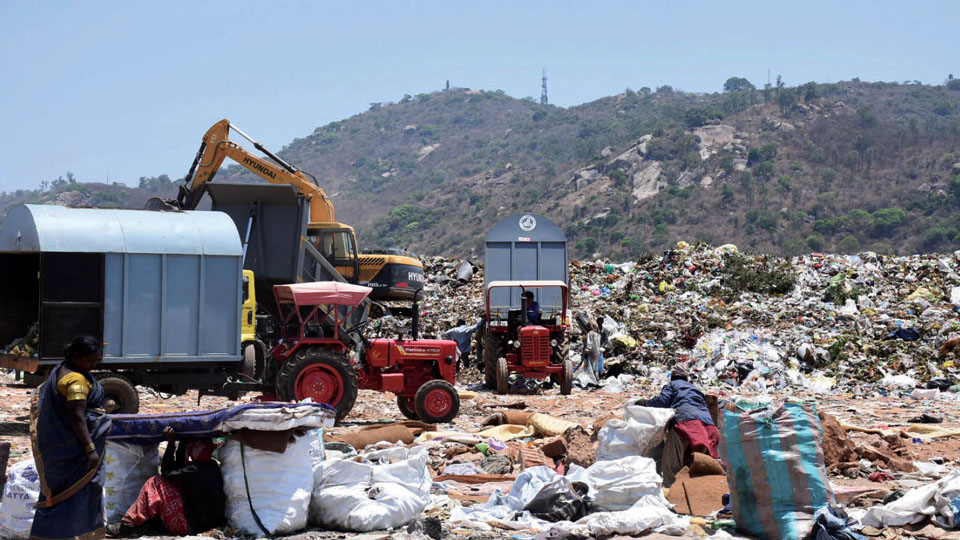By Maj. Gen. (Retd.) S.G. Vombatkere
A voluntary group of citizens, under the banners of Parisara Balaga and Chamundi Betta Ulisi Samiti, has been working and agitating to protect, preserve and save the religious, environmental and heritage ambience of Chamundi Hill.
They seek to especially protect the immediate surroundings of Chamundeshwari Temple and other temples, from the tourism-based development, which the Government of Karnataka is undertaking.
At present, groups of these citizens regularly visit Chamundi Hill and laboriously collect the garbage thrown by tourists who drive up the road to Chamundeshwari Temple. But commercial tourism is a non-stop source of garbage, which volunteers keep collecting.
Garbage, Junk, Waste, Rubbish
The four words abbreviated to ‘GJWR’ are unwanted solid, liquid or gaseous matter, disposed of on land/underground, in water bodies and into the atmosphere. GJWR is unendingly generated by the economic activity of households, vehicles on land, sea and air, and industrial-commercial-business establishments.
It is not commonly appreciated that every industrially manufactured product is finally GJWR — plastic, paper, pins, pens, phones, laptops, cars, aeroplanes, ships, you name it. The fuel and materials consumed at various stages of manufacture of every single product, show up as GJWR and remain unwanted or dangerous for periods ranging from weeks to hundreds of years, and for nuclear wastes, thousands of years.
To keep their cities and surroundings clean, some ‘advanced’ countries export their city civic garbage, dead lead-acid batteries, and even nuclear waste, to countries which have lax laws, and corrupt politicians/ bureaucrats. Their industrial discharge into the atmosphere over the decades is the prime reason for global warming.
Away with GJWR!
Unwanted plastic items, medicine foils, food-packaging aluminium, thermocol packing, batteries, etc., are thrown away into a waste bin. The Mysuru City Corporation (MCC) arranges to take our GJWR away to the city garbage dump. Our ‘away’ is a distant, out-of-sight-and-smelly place, although it is within smelling and visual distance of somebody’s residence like Mysuru’s Vidyaranyapuram.
In India, larger durable consumer goods are stripped down by junk dealers, but finally, reach one or another ‘away’ in whatever form or condition.
The Government has decreed that vehicles more than 15 years old will not be permitted to use the roads. This measure may reduce air pollution in the short term. But in any case, the vehicles will one day be ‘consumed,’ that is, become unusable/ unrepairable, and disposed of in some ‘away’ place.
Thus every industrial product (including recycled GJWR) finally reaches one ‘away’ or another, in solid, liquid or gaseous form, on or under the ground, in the ocean, or in the atmosphere of our Planet. Undeniably, consumption — of whatsoever — leads to pollution in some form in some places.
Who generates GJWR?
Persons having greater disposable incomes use more industrial products and generate more GJWR. So do the more industrialised and wealthy ‘advanced’ countries. Of course, low-income folks also generate GJWR, but much less on a per capita basis, because they consume less due to less disposable income.
City dumps
Municipal Corporations handle GJWR using a combination of Scientific, Technological and Administrative (STA) measures. GJWR of every metro and city is spread over many hectares of land. The piled GJWR spontaneously ignites, emitting toxic fumes. When the fire is extinguished, GJWR smoulders and continues to emit toxic fumes.
Recently, the National Green Tribunal imposed Rs. 100-crore fine on the Kochi Municipal Corporation as compensation for continued neglect, after Kochi was choked with toxic fumes from burning GJWR on its Brahmapuram waste dump.
The fine amount is paid by the Municipal Corporation out of revenue from citizens’ taxes and other public money sources. The State Chief Secretary is to use the fine amount for remediation measures, including public health issues caused by toxic fumes.
Ironically, the people who generated GJWR are themselves affected by the negligent management of their GJWR, and now have to pay a fine from their public sources, to improve the management of their ever-increasing GJWR.
A metro like Mumbai generates 7,000 tonnes of GJWR daily. Even if there is no Kochi-like crisis, eventually the waste dump area will get filled, and the Municipality will need to find another multi-hectares ‘away’ land. Even the best STA measures cannot prevent that new ‘away’ land from getting overfull at some time, as GJWR grows in mass and volume.
We are fast approaching the stage — if we haven’t already reached it — when there is no more land available for GJWR dumping, howsoever efficient the STA methods used.
The reality
Unfortunately, dealing with GJWR is simplistically understood as using STA methods for handling disposal, civic hygiene, and improving water and air quality. It escapes the understanding of our leaders that this is reactive and always inadequate, because of the unending, growing source of GJWR from growing consumption.
We need to think about whether we are looking at the wrong end of the problem. It is a glaring reality that improving STA methods to deal with GJWR, is not working anywhere in the world. City garbage dumps fill up and demand more land, plastics choke huge regions of the ocean, and atmospheric CO2 (Carbon dioxide) levels grow. It is as futile as trying to dry a floor with a mop without shutting off the tap which is discharging water onto the floor.
Chamundi Hill
Reverting to Mysuru’s Chamundi Hill, and even while greatly appreciating the brave and difficult efforts of voluntary groups to clear the garbage, we need to accept that it is futile to laboriously mop up garbage without shutting off the discharge of garbage by commercial tourism.
The only solution is to stop commercial tourism on Chamundi Hill and scrap the Government’s ‘development’ plans for encouraging tourism. But it is necessary to improve genuine pilgrimage access to Chamundeshwari Temple atop the Hill, and preserve the religious sanctity of the heritage precinct and its physical environment.








Recent Comments